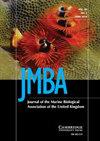奄美断裂带新热喷口区的动物群落
IF 0.9
4区 生物学
Q3 MARINE & FRESHWATER BIOLOGY
Journal of the Marine Biological Association of the United Kingdom
Pub Date : 2024-04-05
DOI:10.1017/s0025315424000304
引用次数: 0
摘要
深海热液喷口承载着以化学合成为基础的生态系统,其中主要栖息着适应特殊环境的动物,这些动物在其他任何地方都无法生存,深度已被证明是日本各地喷口物种组成的主要驱动因素。虽然日本南部的琉球地区有许多热喷口,但只有两个喷口--南延世环和Yoron洞--被发现深度超过1000米。在奄美断裂带共记录到 29 种大型底栖动物,其中包括 19 种喷口特化动物。通过比较三个琉球浅海喷口的物种组成,发现只有三个物种是相同的,这表明三个喷口的群落结构各不相同。奄美裂谷呈现出独特的分带模式,总体上与南恩西比与约龙洞更为相似,但硫化蠕虫 Paralvinella 和贻贝 'Bathymodiolus' platifrons 等关键类群的存在以及共生鳞龙虾 Shinkaia 和瓣鳃蛭 Lepetodrilus 的缺失则体现了其与南恩西的差异。此外,在这两个地点看到的非裂口捕食者也完全不同。总之,奄美裂谷喷口区可被视为一个具有独特动物群落的浅层喷口,今后有必要对形成附近浅层喷口(如奄美裂谷和南延世)大型动物多样性差异的机制进行研究。奄美裂谷位于冲绳海槽和琉球弧的交汇点,其不寻常的地质环境可能会影响流体化学,从而导致这种差异。本文章由计算机程序翻译,如有差异,请以英文原文为准。
Faunal community of a new hot vent field on the Amami Rift
Deep-sea hydrothermal vents host chemosynthesis-based ecosystems inhabited chiefly by specially adapted animals that do not live anywhere else, and depth has been shown to be a major driver of species composition at vents around Japan. Though the Ryukyu region in southern Japan is home to many hot vents, only two – Minami-Ensei Knoll and Yoron Hole – have been found shallower than 1000 m. Here, we report the discovery of a new vent field on the Amami Rift northwest off Amami Ōshima at 630 m deep. A total of 29 macrofaunal species were recorded from Amami Rift, including 19 vent specialists. Comparison of species composition across the three shallow Ryukyu vents revealed only three shared species, highlighting that all three display distinct community structure. Amami Rift exhibits distinct zonation patterns and is generally more similar to Minami-Ensei than Yoron Hole, but the presence of key taxa such as the sulphide worm Paralvinella and the mussel ‘Bathymodiolus ’ platifrons as well as the absence of the symbiotic squat lobster Shinkaia and the limpet Lepetodrilus exemplify its difference with Minami-Ensei. Furthermore, the non-vent specific predators seen in these two sites were completely different. Overall, the Amami Rift vent field can be considered a shallow vent with a unique set of fauna, warranting future research on the mechanisms shaping disparate macrofaunal diversity between nearby shallow vents such as Amami Rift and Minami-Ensei. The unusual geological setting of Amami Rift at the converging point of Okinawa Trough and Ryukyu Arc may influence fluid chemistry to drive such differences.
求助全文
通过发布文献求助,成功后即可免费获取论文全文。
去求助
来源期刊
CiteScore
2.30
自引率
8.30%
发文量
68
审稿时长
3-8 weeks
期刊介绍:
JMBA is an international journal, publishing original research on all aspects of marine biology. It includes pioneering work taking place today on major issues concerning marine organisms and their environment. Subjects covered include: ecological surveys and population studies of marine communities; physiology and experimental biology; taxonomy, morphology and life history of marine animals and plants; and chemical and physical oceanographic work. Included with 2010 online subscriptions: Marine Biodiversity Records.

 求助内容:
求助内容: 应助结果提醒方式:
应助结果提醒方式:


